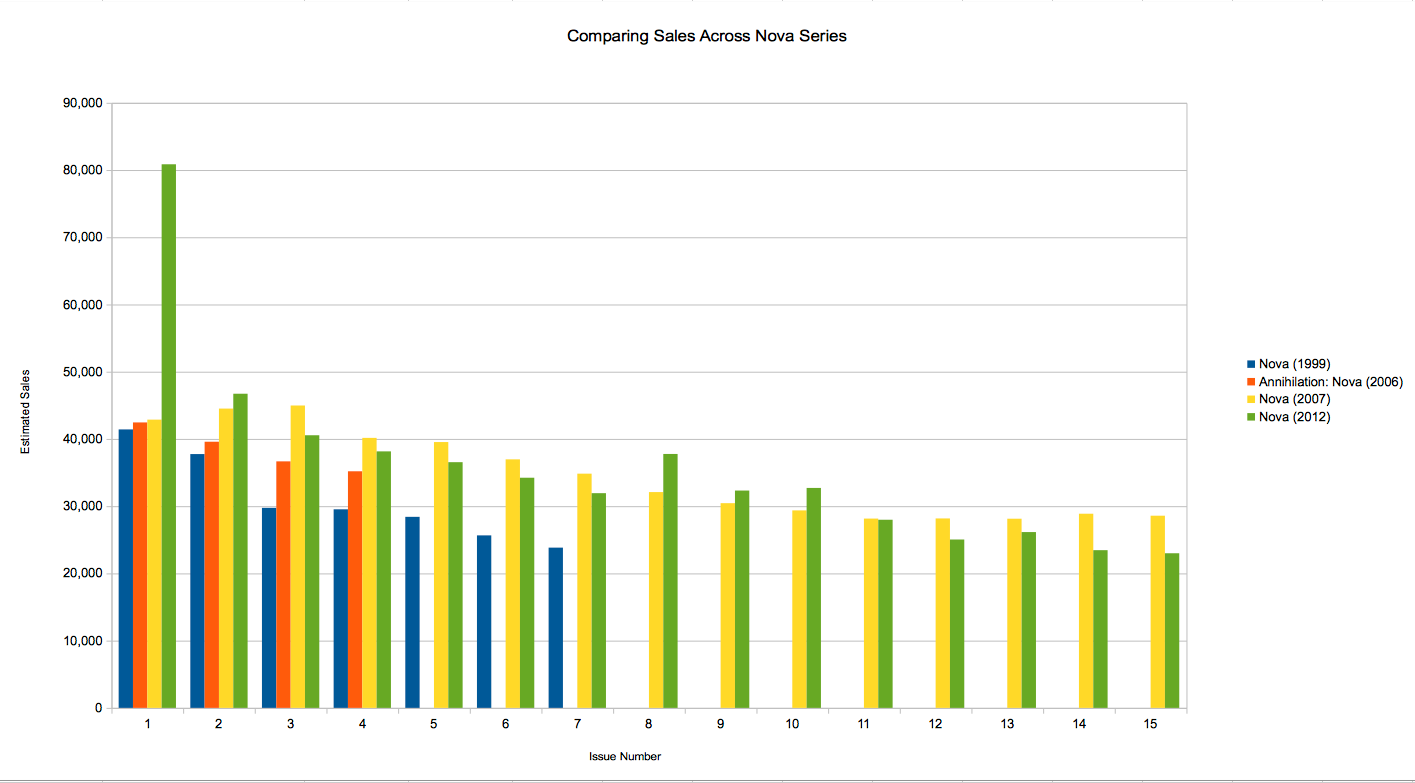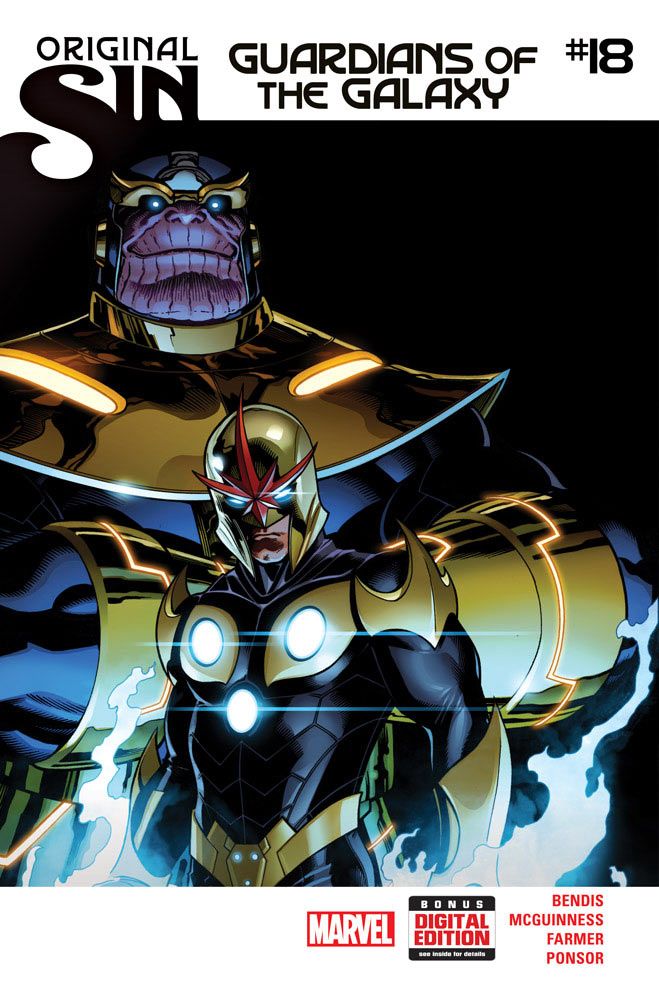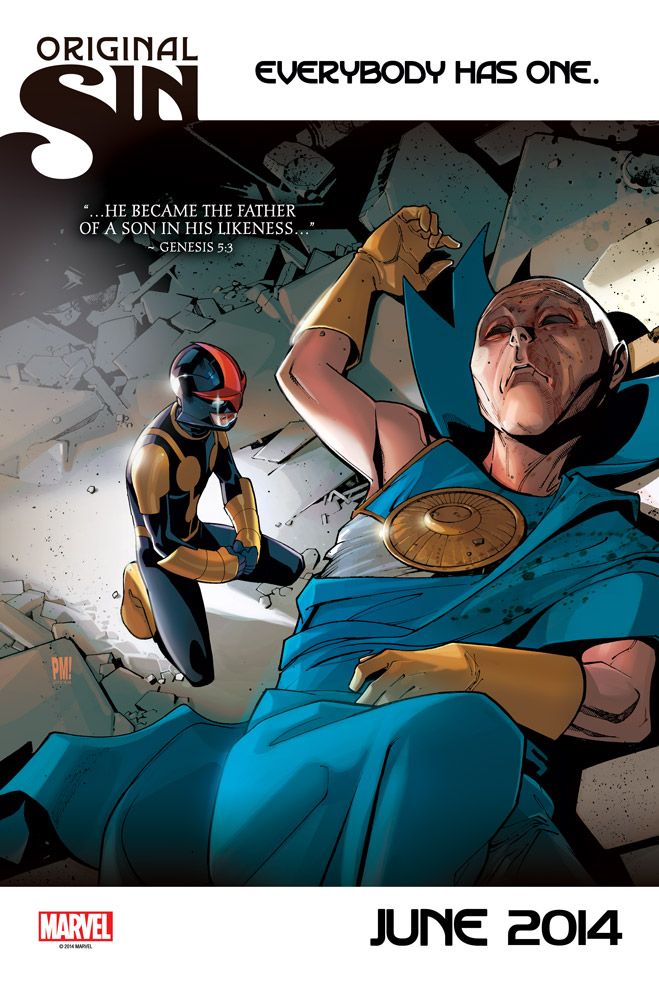Marvel announced on Monday that as part of its "Original Sin" event, the fate of the original Nova, Richard Rider, finally will be revealed in August's Guardians of the Galaxy #18, by Brian Michael Bendis and Ed McGuinness. The character last appeared in 2010; since then, the mantle of Nova has been held by Sam Alexander, who's yet to win over vocal fans of the original Human Rocket.
Green Lantern fans are probably having a '90s flashback right about now. While Richard Rider wasn't turned into a homicidal villain, he and Hal Jordan both were summarily shuffled off at the climax of a big event to make way for a younger replacement. Longtime readers initially hated Kyle Rayner, but DC Comics stuck to its guns, as over the following decade he remained the primary Green Lantern in the DC Universe. While a vocal minority never relented, the work of writer Ron Marz and others attracted a new following for the character, and converted some old fans too. Rayner remains a major character in the Green Lantern titles today, even after the return of Jordan in 2005.
A similar story has been playing out at Marvel, although we don't yet know whether Rider will experience a similar triumphant return. As with the Green Lantern Corps, the Nova Corps concept allows for others to take over the role of Nova. So someone other than Rich Rider being Nova isn't far-fetched -- in fact, Nova has given up or lost his powers on a number of occasions since his 1976 debut. And other Novas have taken his place, although usually they ended up as villains.
However, Nova is no Green Lantern. While there are some conceptual overlaps, Nova just hasn't had the same longevity or stability as Green Lantern. Marv Wolfman introduced the character as a way to bring back some of the classic, carefree Spider-Man vibe he felt was slipping away in the mid-'70s. The character, and his book The Man Called Nova, was intended for newer, and slightly younger, readers. It won over some fans, but the industry just wasn't in any shape to support it. After a year and a half, the title moved to a bimonthly schedule, and a year and a half later it was canceled.
The character had some guest appearances, but by the early '80s, he was gone. He returned in the early '90s as part of New Warriors, and despite beginning with the embarrassing Kid Nova moniker, he eventually earned his own spinoff series. Everything might've worked out, except that it was the '90s, and halfway through the decade the direct market crashed, and both series were canceled; Erik Larsen's attempt at a third series in 1999 lasted just seven issues. Meanwhile, aside from a brief hiccup or two, there has been a near-continuous string of Green Lantern series or miniseries since 1960.
To put it mildly, Nova fans have a bit of an inferiority complex. They see great potential in the character, and yet it was so rarely realized. That all changed with the 2006 event miniseries Annihilation, and its companion prequel Annihilation: Nova. Suddenly Nova was burdened with the power of the entire Nova Corps, the rest having been killed off in a brutal alien invasion. On top of survivor's guilt, he had to deal with a computer uploaded into his brain lecturing him on responsibility. The result was a fun twist on the buddy-cop concept, with the by-the-book partner living inside the head of the rogue officer. Aside from that great conceptual twist and writing, the miniseries and the subsequent Nova series that followed, the character was finally being taken seriously as a hardcore superhero/science fiction mash-up. Some fans had waited 30 years for this: It was a huge payoff, and for the cyclical illusion of change usually found in superhero comics, incredibly unlikely and unexpected.
That Nova series ran for 36 issues, longer than any before it. But the Laws of Comic Sales Attrition eventually won out and the series, and its sister title Guardians of the Galaxy, were discontinued with lead-ins to The Thanos Imperative miniseries, which ended with the two stars of those books, Nova and Star-Lord, locking themselves off in another dimension to stop the invasion. It was far from going out with a whimper. It's the kind of development you wish major characters would get. But if you're going to get actual character development, an arc has to end. And so it did. For their service, writers Dan Abnett and Andy Lanning were canonized by Nova fandom.
But this being monthly superhero comics, that wasn't really the end. Suddenly Star-Lord resurfaced with nary an explanation of what happened in that cancerous dimension, while Nova remained MIA. Meanwhile, the minds behind the Ultimate Spider-Man animated series were eyeing Nova as part of their supporting cast of heroes, and somewhere along the line it was probably decided some cast diversity would be nice. So Marvel's Head of Television Jeph Loeb created the Hispanic Sam Alexander as the new Nova. Named after Loeb's late son, the character quickly debuted in Marvel's comics ahead of the show's premiere, although it was initially unclear whether he was Rich Rider or someone new. After Ultimate Spider-Man's first season began, a new Nova series by Loeb and Ed McGuinness followed. By then it was clear in several ways that this wasn't Rich Rider.
Fans who had finally gotten three years of what they wanted, after waiting for 30 years, were none too happy. This new Nova was a dopey kid who had little knowledge of Rich Rider or the Nova Corps history. The series itself was barely acknowledging Rich Rider. Where was he?
But for those not clinging on to a lifetime of dashed hopes, it wasn't a total loss. In a rare moment of synchronicity with the animated series, the comic was being written for a younger audience, the same one that might also be watching Nova on television. While probably unintentional, it was a nice nod to Wolfman's original idea for the character: an accessible, fun adventure for those that haven't been reading comics for decades.
And the series hasn't been without an awareness of its history: The legacy of the Nova Corps and Rich Rider hangs over the book, both in how other characters compare Sam to his predecessor, and how his father's disappearance, possibly tied to Rich Rider's own, remains unsolved. The series is even lightly peppered with allusions to Sam's time as a Nova being finite. Yes, the writing has been choppy and overly cutesy at times, but under the current creative team of Gerry Duggan and Paco Medina, it has finally found its footing. Sam is a truly likable hero in the classic Marvel sense: He's in over his head, he's flawed, he has trouble at home, and he's doing the best he can. In many ways, it is a spiritual successor to the original Nova of the '70s . Having said all of that, I don't necessarily enjoy it more than Abnett and Lanning's Nova, which I do miss. But the reality is this is what we have: a Nova for a new generation. He doesn't need to speak to me.
So will Richard Rider really return this August? I suspect we're only going to learn of his fate. Even Marvel.com's interview positions the story as Star-Lord revealing what happened to him, and oh yeah, by the way, Nova too. So I'm not expecting a triumphant return. So is that it? No Rich Rider for 10 years? As Tom Brevoort, Marvel's senior vice president of publishing, points out at least once a week on his blog, Marvel follows the sales. If no one is buying Sam Alexander, he'll fade away and Rich Rider will probably come back. So if sales could indicate Sam's longevity and Rich's return, let's take a look at sales:
Diving into The Comics Chronicles sales estimates, I created a handy chart comparing sales estimates of the last four Nova series, which is about as much is publicly known about the character's sales history. The first issue of Nova by Loeb and McGuinness did more than double the sales of every other Nova series since the late '90s. After that, it drops down, setting pretty much neck and neck with Abnett and Lanning's Nova, usually trailing slightly behind and occasionally slightly passing it. With the last few issues, it's started to sink lower, but the character is about to get a big push as a significant character in Marvel's summer tentpole Original Sin. Two tie-in issues will also no doubt give the series a sales boost. The Abnett and Lanning series was also tying in to an event at Issue 17, which it continued to do every year until it was canceled. Sam Alexander may end up being put on a similar track if his numbers keep dipping to the low 20,000s. Another factor is that the Sam Alexander Nova benefits from another sales channel that no other Nova had the benefit of: Digital sales have been projected by some creators to be about 10 percent of print and still increasing. It's impossible to know for sure, but that could be closing the gap between the two series' sales. Of course, the entire 2007 Nova series has since been made available digitally, so it's likely retroactively racking up sales too, but comiXology's bestseller lists consistently suggest that new releases sell better than material that's been sitting there, which is consistent with trends of other entertainment products.
However you cut it, it's fair to say the two Novas are reasonably equal in terms of sales. We might see Sam Alexander around for 36 issues before some new status quo is presented. Or maybe Rich Rider will indeed return in Guardians of the Galaxy #18, and he and Sam will form a new buddy-cop dynamic. It's easy to complain about the stale recycling of superhero comics, but who would've thought Rich Rider would get a true hero's journey. These comics can still surprise, so best to strap in and see where the ride takes us.



